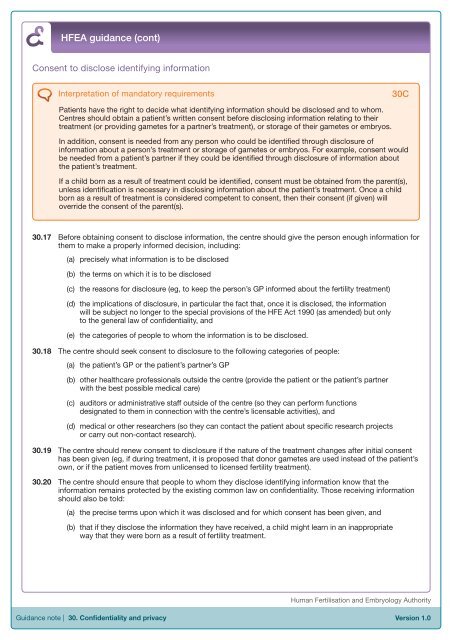Eighth Edition - R.3 - Human Fertilisation & Embryology Authority
Eighth Edition - R.3 - Human Fertilisation & Embryology Authority
Eighth Edition - R.3 - Human Fertilisation & Embryology Authority
You also want an ePaper? Increase the reach of your titles
YUMPU automatically turns print PDFs into web optimized ePapers that Google loves.
HFEA guidance (cont)<br />
Consent to disclose identifying information<br />
Interpretation of mandatory requirements<br />
Patients have the right to decide what identifying information should be disclosed and to whom.<br />
Centres should obtain a patient’s written consent before disclosing information relating to their<br />
treatment (or providing gametes for a partner’s treatment), or storage of their gametes or embryos.<br />
In addition, consent is needed from any person who could be identified through disclosure of<br />
information about a person’s treatment or storage of gametes or embryos. For example, consent would<br />
be needed from a patient’s partner if they could be identified through disclosure of information about<br />
the patient’s treatment.<br />
If a child born as a result of treatment could be identified, consent must be obtained from the parent(s),<br />
unless identification is necessary in disclosing information about the patient’s treatment. Once a child<br />
born as a result of treatment is considered competent to consent, then their consent (if given) will<br />
override the consent of the parent(s).<br />
30C<br />
30.17 Before obtaining consent to disclose information, the centre should give the person enough information for<br />
them to make a properly informed decision, including:<br />
(a)<br />
precisely what information is to be disclosed<br />
(b)<br />
(c)<br />
the terms on which it is to be disclosed<br />
the reasons for disclosure (eg, to keep the person’s GP informed about the fertility treatment)<br />
(d) the implications of disclosure, in particular the fact that, once it is disclosed, the information<br />
will be subject no longer to the special provisions of the HFE Act 1990 (as amended) but only<br />
to the general law of confidentiality, and<br />
(e)<br />
the categories of people to whom the information is to be disclosed.<br />
30.18 The centre should seek consent to disclosure to the following categories of people:<br />
(a) the patient’s GP or the patient’s partner’s GP<br />
(b)<br />
(c)<br />
(d)<br />
other healthcare professionals outside the centre (provide the patient or the patient’s partner<br />
with the best possible medical care)<br />
auditors or administrative staff outside of the centre (so they can perform functions<br />
designated to them in connection with the centre’s licensable activities), and<br />
medical or other researchers (so they can contact the patient about specific research projects<br />
or carry out non-contact research).<br />
30.19 The centre should renew consent to disclosure if the nature of the treatment changes after initial consent<br />
has been given (eg, if during treatment, it is proposed that donor gametes are used instead of the patient’s<br />
own, or if the patient moves from unlicensed to licensed fertility treatment).<br />
30.20 The centre should ensure that people to whom they disclose identifying information know that the<br />
information remains protected by the existing common law on confidentiality. Those receiving information<br />
should also be told:<br />
(a)<br />
the precise terms upon which it was disclosed and for which consent has been given, and<br />
(b) that if they disclose the information they have received, a child might learn in an inappropriate<br />
way that they were born as a result of fertility treatment.<br />
<strong>Human</strong> <strong>Fertilisation</strong> and <strong>Embryology</strong> <strong>Authority</strong><br />
Guidance note | 30. Confidentiality and privacy<br />
Version 1.0

















